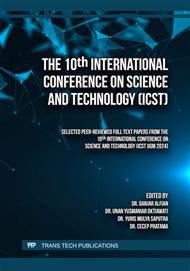p.238
p.249
p.256
p.273
p.304
p.318
p.329
p.343
p.356
Development of STM8 and Kalman Filter Based Heater Controller for Automatic Tissue Processor
Abstract:
A tissue processor is a device that automatically processes tissue into several steps for histological studies in medical or biological laboratories. One of the stages of this device is embedding, where the tissue is inserted into a vessel that is heated to a stable temperature of 60 to 80°C so that the paraffin remains liquid during this process. The handling of tissue specimens is a crucial aspect of ensuring an accurate diagnosis of the tissue. However, due to its high cost, it can affect scientific development that requires tissue processing. Reverse engineering is one of the methods commonly used to develop a tool at a lower price; one way is to change the essential components used while still maintaining the device's primary function. This research aims to develop a heater controller for a tissue processor using STM8 and LM35 analog sensors equipped with a Kalman filter. The design of the Kalman filter will be determined based on its component equations. The measurement and variance constant values will be simulated and analysed in MATLAB for the most suitable parameter value. Afterwards, the proposed design will be conducted using the Arduino Integrated Development Environment (IDE) to reduce the noise in the LM35 sensor reading and then saved using ArduSpreadsheet. The simulation and implementation results provide evidence that the proposed Kalman filter effectively filters signals contaminated with noise, even in the presence of high data variations that may occur in sensor readings. In testing, it is necessary to pay attention to the ratio that can reduce noise while keeping the characteristics of the sensor itself. Numerous investigations have explored various ratios, recommending an appropriate ratio of 100. Based on the implementation of this ratio with measurement constant (R) 10 and variance constant (Q) 0.1, resulted in a 0.29°C mean error and stable sensor readings.
Info:
Periodical:
Pages:
304-317
Citation:
Online since:
October 2025
Price:
Сopyright:
© 2025 Trans Tech Publications Ltd. All Rights Reserved
Share:
Citation:


